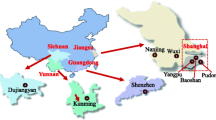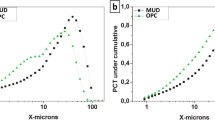Abstract
The content of total hexavalent chromium (CrVI), total chromium (Cr) and other metals (Fe, Mn, Ni and Co) was determined in the cement matrix of concrete present in samples collected in both old and recent buildings located in the town of Modena (northern Italy). The cement matrix of concrete was obtained by eliminating the aggregate components by means of disaggregation and was ground until it could pass through a 63-μm-sieve. In addition, samples of bagged commercial cements were considered. Metal determination was obtained by inductively coupled plasma optical emission spectroscopy after strong acid dissolution (HCl–HNO3). Total Cr(VI) determination was obtained after mild acid attack (HCl) and analysed by UV–Vis spectrophotometry. Analytical data values obtained indicate that the highest concentrations of metals were found in concrete and in bagged cement samples characterized by high Fe concentration. High Cr(VI) concentrations both in the cement matrix of concrete and in cement samples were found in total Cr-rich samples. Cr(VI) concentrations were about 20–30% of total Cr. The data obtained indicate that secondary raw materials and industrial by-product powders utilized in the modern cement industry may significantly increase Cr(VI) in concrete.




Similar content being viewed by others
References
ATILH (2003) Chromium in cement, origin and possible treatments. ATILH Center for information and documentation, September 2003
Burns RG, Burns WM, Turekian KK (1974a) Cobalt. In: Wedepohl KH (ed) Handbook of geochemistry. Springer, Berlin, Heidelberg, New York
Burns RG, Burns WM, Turekian KK (1974b) Nickel. In: Wedepohl KH (ed) Handbook of geochemistry. Springer, Berlin, Heidelberg, New York
CEMBUREAU (2006) Activity Report 2006. Published by CEMBUREAU The European Cement Association, No Editeur: D/2007/5457/May
CEN (2006) EN196-10 methods of testing cement—part 10—determination of the water soluble chromium (VI) content of cement. European Committee for Standardization, Bruxelles
Clescerl LS, Greenberg AE, Eaton DA (eds) (1999) Standard methods for the examination of water and wastewater, 20 th edn. United Book Press Inc, Baltimore
Eštoková A, Palaščáková L, Singovszká E, Holub M (2012) Analysis of chromium concentrations in cement materials. Proc Eng 42:123–130
Eštoková A, Palaščáková L, Kovalčíková M (2016) Chromium-leaching study of cements in various environments. World Acad Sci Eng Technol Int J Civ Environ Struct Constr Archit Eng 10(6):666–669
Frey BE, Riedel GF, Bass AE, Small LF (1983) Sensitivity of estuarine phytoplankton to hexavalent chromium. Estuar Coast Shelf Sci 17:181–187
Giergiczny Z, Król A (2008) Immobilization of heavy metals (Pb, Cu, Cr, Zn, Cd, Mn) in the mineral additions containing concrete composites. J Hazard Mater 160:247–255
Gizaw Z, Yifred B, Tadesse T (2016) Chronic respiratory symptoms and associated factors among cement factory workers in Dejen town, Amhara regional state, Ethiopia, 2015. Multidiscip Respir Med 1:11–13
Goldschmidt VM (1962) Geochemistry. In: Muir A (ed) Oxford Clarendon Press, Oxford
Hills L, Johansen V (2007) Hexavalent chromium in cement manufacturing: literature review. Portland Cement Association, Skokie, p 13
IARC (2006) Cobalt and inorganic cobalt compounds. Concise international chemical assessment document 69, International Agency for Research on Cancer, World Health Organization, Geneva, Switzerland
IARC (2011) Nickel and nickel Compounds. IARC monographs on the carcinogenetic risk to humans, vol 100c, International Agency for Research on Cancer, World Health Organization, Geneva, Switzerland
IPCS (2004) Concise international chemical assessment document 63 manganese and its compounds: environmental aspects. World Health Organization, Geneva
IPCS (2013) Concise international chemical assessment document 78 inorganic-chromium(VI) compounds. World Health Organization, Geneva
Kiilunen M (1997) Occupational exposure to chromium and nickel in the 1980s in Finland. Sci Total Environ 199:91–101
Klemm W (2000) Contact dermatitis and the determination of chromates in hydraulic cements and concrete. Portland Cement Association, Technical report
Kovalčíková M, Eštoková A (2014) Monitoring of heavy metal concentrations in concrete leachates. 9th International Conference Environmental Engineering, May 22–23, Vilnius, Lithuania, Article number: enviro.2014.033, 1–6
Kridin K, Bergman R, Khamaisi M, Zelber-Sagi S, Weltfriend S (2016) Cement-induced chromate occupational allergic contact dermatitis. Dermatitis 27:208–214
Laforest G, Duchesne J (2005) Immobilization of chromium (VI) evaluated by binding isotherms for ground granulated blast furnace slag and ordinary Portland cement. Cem Concr Res 35:2322–2332
Lee HS, Lee CG, Kim DH, Song HS, Kim JY, Park CH, Ahn SC, Yu SD (2016) Emphysema prevalence related air pollution caused by a cement plant. Ann Occup Environ Med 28:17. doi:10.1186/s40557-016-0101-8
Leisinger SM, Bhatnagar A, Lothenbach B, Annette Johnson C (2014) Solubility of chromate in a hydrated OPC. Appl Geochem 48:132–140
Lizarraga S (2003) Chromium VI in Cements. In: Proceedings of the 5th colloquium for managers and technicians of cement plants, 25–27 February 2003, Seville, Spain
Nordby KC, Notø H, Eduard W, Skogstad M, Fell AK, Thomassen Y, Skare Ø, Bergamaschi A, Pietroiusti A, Abderhalden R, Kongerud J, Kjuus H (2016) Thoracic dust exposure is associated with lung function decline in cement production workers. Eur Respir J 48:331–339
Persoone G, Van de Vel A, Van Steertegem M, De Nayer B (1989) Predictive value of laboratory tests with aquatic invertebrates: influence of experimental conditions. Aquat Toxicol 14:149–166
Persson D, Kucera V (1998) Release and flows of metals from building materials due to corrosion and degradation. In: Proceedings of the CIB world building congress, Gävle, Sweden, 7–12 June 1998
Persson D, Kucera V (2001) Release of metals from buildings, constructions and products during atmospheric exposure in Stockolm. Water Air Soil Pollut Focus 1:133–150
Peysson S, Péra J, Chabannet M (2005) Immobilization of heavy metals by calcium sulphoaluminate cement. Cem Concr Res 35:2261–2270
Rafeemanesh E, Alizadeh A, Saleh LA, Zakeri H (2015) A study on respiratory problems and pulmonary function indexes among cement industry workers in Mashhad, Iran. Medycyna Pracy 66:471–477
Riedel GF (1985) The relationship between chromium(VI) uptake, sulphate uptake, and chromium(VI) toxicity in the estuarine diatom Thalassiosira pseudonana. Aquat Toxicol 7:191–204
Serclérat I, Moszkowicz P, Pollet B (2000) Retention mechanisms in mortars of the trace metals contained in Portland cement clinkers. Waste Manag 20:259–264
Sharma DK, Sharma R (2015) Use of variamine blue dye in spectrophotometric determination of water soluble Cr(VI) in Portland cement. Orient J Chem 31:1–4
VDZ (1996) Activity Report (1993–1996) German Cement Workers Association. Research Institute of Cement Industry, Düsseldorf
Vestbo J (1993) Predictors of mortality, COPD morbidity, and respiratory cancer with special reference to respiratory symptoms, lung function, and occupational exposure cement dust. Dan Med Bull 40:1–16
White WM (2013) Geochemistry. Wiley, Chichester
Yamaguchi O, Masaya I, Yasushiro U, Shunzuke H (2006) A method for the determination of total Cr(VI) in cement. J Eur Ceram Soc 26:785–790
Acknowledgements
Thanks are due to two anonymous Reviewers and to the Editor-in-Chief James W. LaMoreaux for their comments which allowed improvements to be made to the text.
Author information
Authors and Affiliations
Corresponding author
Rights and permissions
About this article
Cite this article
Costeri, E., Martinelli, G., Sighinolfi, G. et al. Hexavalent chromium and some trace metals in concrete from buildings of different ages in northern Italy. Environ Earth Sci 75, 1420 (2016). https://doi.org/10.1007/s12665-016-6231-z
Received:
Accepted:
Published:
DOI: https://doi.org/10.1007/s12665-016-6231-z




